Over the summer I decided to give my kids an old Apple laptop to share.
We use laptops for school homework from time to time but my kids spend most of their screen time poking and swiping tablets. I wanted to broaden their horizons a little: do a bit of coding; a bit of web searching; get them comfortable with a keyboard; give them something valuable that they had to look after; and get the ball rolling with developing some good computer security habits.
The kids have been at school for a few years and they’re are old enough to have a little independence, but most of what they do is supervised or subject to fairly restrictive boundaries.
The Mac would be no exception, there would be boundaries, so I enlisted its in-built parental controls to see what they could do, and how they could help.
This article walks you through the things I did to secure the laptop, and details the parental controls and options I chose. Later this week we’ll walk you through a similar setup for a Windows machine so stay tuned for that.
A clean slate
Because I was reusing an old laptop I decided to wipe it clean and start again. I reinstalled macOS over the internet on to an encrypted filesystem, went through the setup process until I had a working computer with one user account and installed Sophos Home.
I do this whenever a computer changes hands, even in the same household, but it’s not a prerequisite for setting up parental controls. I’m just letting you know what state my laptop was in when I wrote these steps.
All you need is a working Mac that you’re happy for your kids to spend some time on. What is important is that each of your children starts with their own clean slate: a user account that’s theirs and nobody else’s.
Users
As our starting point I will assume you have a working Mac on which you have Admin rights.
Log on to your Mac and go to System Preferences > Users & Groups. On the left hand side is a list of users. Under your name it should say Admin.

Before setting up parental controls we need to create an account for each child. To add an account, click on the + button.
When the new user dialog opens choose Managed with Parental Controls from the drop down and fill in the rest of your child’s details. I suggest you enter a placeholder password at this point – you can help your child to change it later.
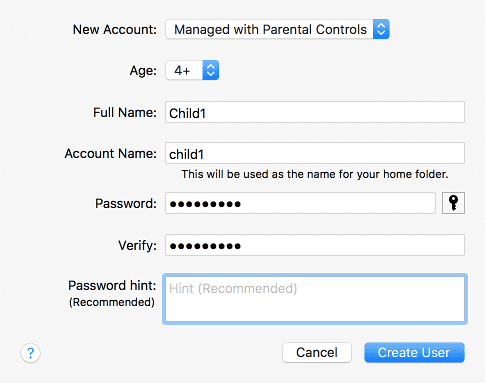
When you click Create user you’ll see that your child has been added to the list of users on the left, and that Enable parental controls is ticked.
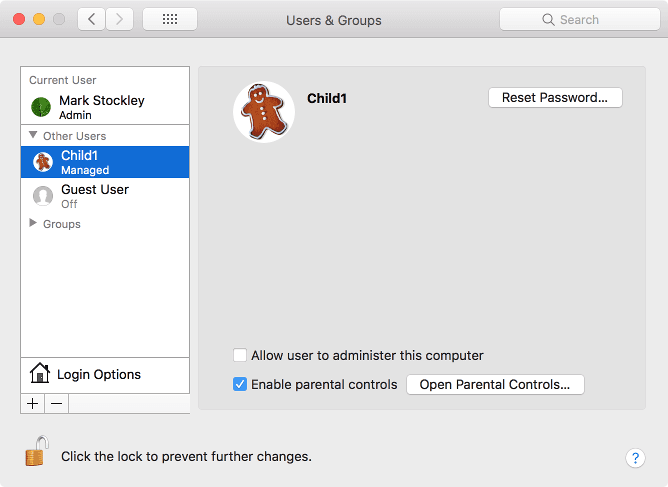
Highlight the child’s name in the left hand menu and click the Open Parental Controls… button.
Parental controls
Different families will require different settings so I’m going to take you through the very restrictive set that I used, as an example, but your mileage may vary.
Whatever your choices, I suggest you apply the principle of least privilege, giving your children the access they need, and no more. If I couldn’t immediately think of a sensible use case for allowing something, I switched it off. It’s easy to change the settings if later if you get something wrong.
As you go through the controls, pay careful attention to the labels because you’ll be using ticks to indicate both positives and negatives – sometimes your tick means allow, at other times it might be disable or restrict.
There are six tabs in the parental controls pane: Apps, Web, Stores, Time, Privacy and Other.
Apps
The Apps tab lets you limit access to the computer’s camera, set restrictions on email and multiplayer games, and create an allow list of apps.
I couldn’t think of a reason my children would need the camera or multiplayer games so I unticked Allow use of camera and Allow joining Game Center multiplayer games.

To restrict who can exchange emails with your child tick Limit Mail to allowed contacts and click the Manage… button.
I ticked Send requests to and entered my email address so that I’ll be notified of any attempts to email sombody who isn’t on the allow list.
Click the + button and add the names and email addresses of the contacts you’ll allow.
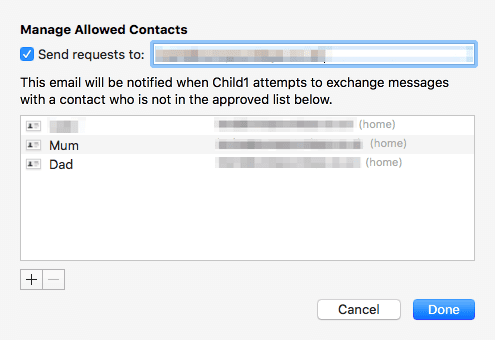
Click Done to return to the Apps tab.
Next, tick Limit Applications on this Mac. Click the arrows to list the apps on your computer. Again, I suggest you take the attitude that everything is off limits unless you have a reason for it not to be.
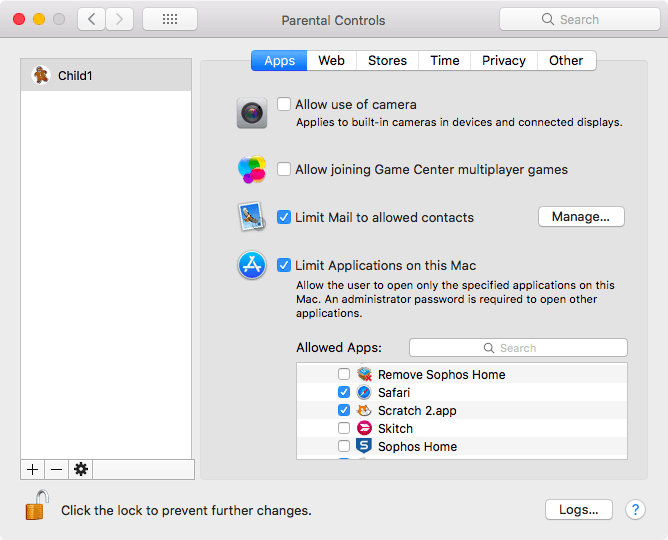
In my screenshot you’ll see that Safari is ticked, giving the child access to the entire web, warts and all. I used the controls in the next tab, Web, to rein that in.
Web
To put some boundaries on my child’s web access I clicked on the Web tab and selected Allow access to only these websites. To add a website to the list click the + button.

If you want to give your kids more freedom then the second option, Try to limit access to adult websites, might be worth a try. Note that Apple is very clear that it’s trying to limit access with this tool. No filter is foolproof so if you choose this option, understand that undesirable sites may get through the filter, and some legitimate sites might not.
If you enable that option you can also use the Customize… button to open a dialog where you can set your own block and allow lists to supplement Apple’s adult website filtering.
Stores
Under the Stores tab you can set up controls for accessing TV shows, books and movies, as well as Apple’s online stores. I ticked options to disable iTunes Store, iTunes U and the iBooks Store.
I also ticked to restrict Music with explicit content, and then ticked Movies to:, TV shows to: and Apps to:, and choose age-appropriate values from their drop downs. Finally, I ticked to restrict Books with explicit sexual content. I couldn’t imagine a situation where that would actually be necessary but the principle of least privilege applies – the child doesn’t need it, so they don’t get it.
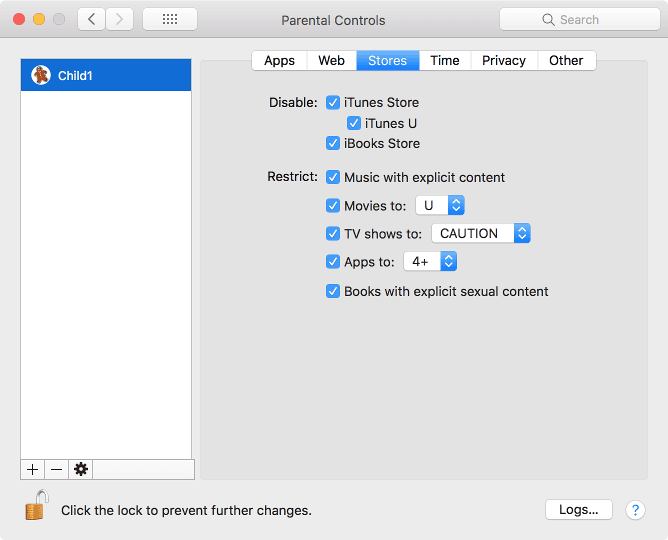
Time
The controls under the Time tab allow you to specify how long your child can use the laptop for, and at what times of day. I chose to limit time to one hour per day at times of day when they’re normally awake.
To cap the amount of time to one hour per day, tick Limit weekday use to and Limit weekend use to, and set the sliders to 1 hour a day.
To prevent access overnight I ticked School nights and Weekend, and set the times to 20:00 and the finish times to 07:30.

Privacy
The Privacy tab limits access to your kids’ data. Under Allow changes to you’ll see a list of items that can be changed by apps on the computer. For example: ticking Contacts allows apps to create new contacts in the address book and unticking it stops that.
I couldn’t think of a good reason to allow Twitter and Facebook so they’re unticked.
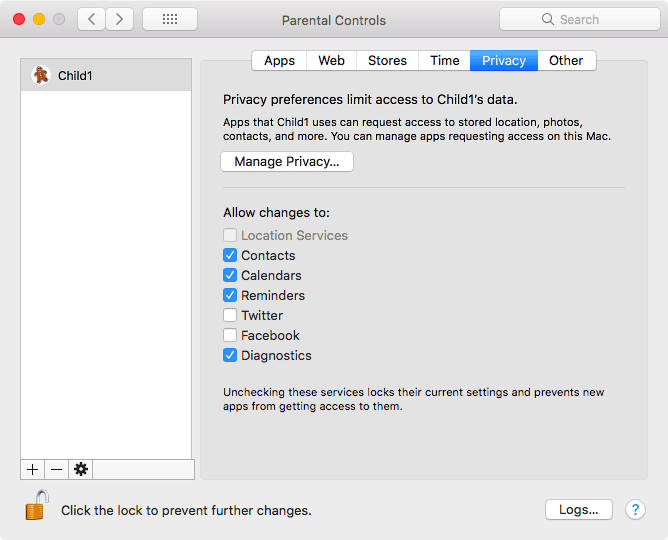
The Manage Privacy… button at the top allows you to see which apps have access to which services on the Mac, and to decide if you’re prepared to allow it. So, if you want Siri and Maps to have access to Location Services, you can set it here.
Either because my Mac was pretty bare, or because of the options I selected when setting up the Mac (such as disabling Siri entirely), there was nothing for me to untick here.
Note that clicking Manage Privacy… kicks you out of the Parental Controls pane and opens up the Privacy tab of the Security & Privacy pane. When you’re done just click the back button to return to the Privacy tab under Parental Controls where you started.
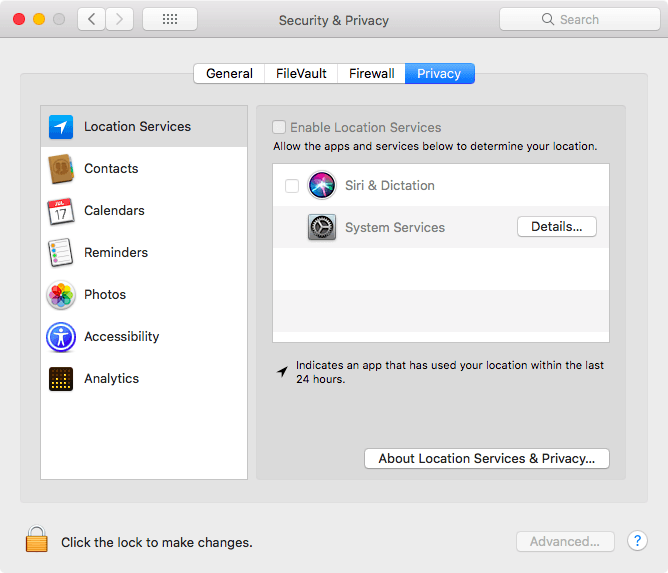
Other
The last tab in the row is Other, and it’s where Apple has swept all the things that don’t fit anywhere else under one rug. Note that the first five options are negative and the last, Use Simple Finder, is positive.
I elected to untick Prevent the Dock from being modified, so my child could customise the appearance to their liking (see the passwords section below for more on that), and I elected to Use Simple Finder, because computers are baffling enough when everything is new.

Remote setup
Hidden away where you’ll never, ever find it is an option to enable remote control of a computer’s parental controls. This feature allows you to modify the parental controls on your child’s computer from another Mac on the same network.
To enable it, click on the settings icon (the cog) under the list of children’s names on the left of the Parental Controls pane, and click Allow Remote Setup.
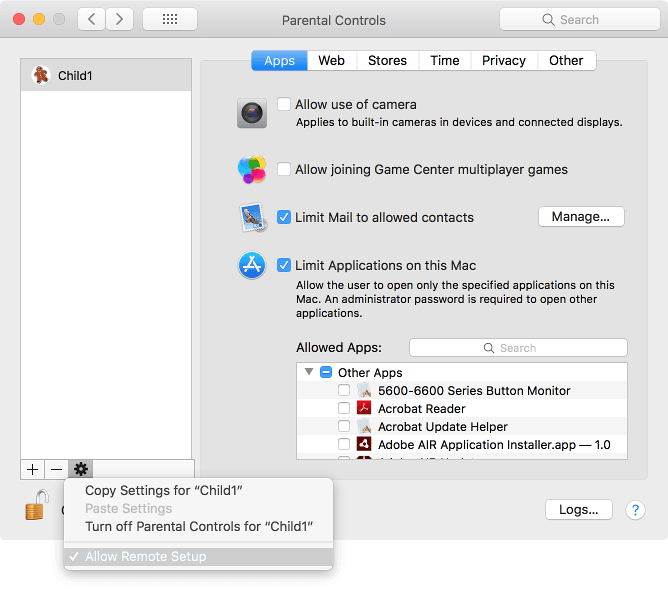
If you log into a different Mac on the same network and go to System Preferences > Parental Controls you’ll see the name of your child’s computer. If you click on it you’ll be asked for the username and password of a user with Admin rights on that computer. Once you’ve logged in you’ll be able to select your child’s name and modify their parental controls as if you were sat at their computer.
Security & Privacy
Outside of the parental controls there are a few other settings worth paying attention to. In System Preferences open the Security & Privacy pane.
Under the General tab tick Require password and then choose the shortest time you think your child can stand from the drop down list. This gets them used to the idea of logging in to the computer again if they leave it for a while, which is a good habit to develop.
I suggest you also turn on the firewall by clicking the Firewall tab selecting Turn On Firewall.
Passwords
Once the machine is set up, it’s time to introduce your children to it. While I was getting my kids’ laptop ready I spent a lot of time thinking about how to get them on the right track with computer security.
I wanted to get them doing some important things right, straight off the bat, so that they become habits – preferably things that I could build on as they got older, but without bewildering them.
I decided to focus on one thing – passwords are supposed to be secret.
There’s more to creating a strong password than that, of course, but it’s an essential building block. We’ll tackle password complexity when they’re older. For now I decided it’s enough for me that they choose passwords they can remember, so that they can practice keeping them secret.
When it came time for them to choose their passwords we made a performance of it: I told them why we don’t share passwords and that passwords need to be secret, from everyone, forever, even me. I had them choose passwords without telling me what they were, and then they typed them into the computer without me watching.
In that moment, frequently through the day, and occasionally through the summer that followed, we made a game of it by asking them “hey, what’s your password?”, at unexpected moments.
Knowing we’re trying to trick them, they take great pride in not giving them up!
At the same time as they chose their passwords I had them choose their own icon and a desktop background. I’m hoping that this basic personalisation will make them want to log in as themselves, and log out if they open the computer and see somebody else’s desktop.
I want to encourage the idea that it’s normal to have your own account on a computer, and that sharing accounts is a bad idea. (I’ve more or less given up with the adults on this one and decided the only chance for progress is raising a generation that just knows that sharing accounts is bad!)

Simon McAllister
NIce article, Mark. Particularly like (and agree with) your acceptance regarding adults :)
My only concern here is a potential fight between well privacy-educated users and border control insisting on visitors disclosing their passwords.
MikeP_UK
Glaringly, there is no mention of setting the users’ language correctly. The Operating System only offers the choice of English, but all the spell checkers must be set to the appropriate language for the users’ location. In the UK that must be set to UK English else you will get US English spelling – which are unacceptable in the UK. Likewise other users languages should set appropriately for their location.
Mark Stockley
A fine addition, thanks.
Bryan
Thanks for this Mark (well done as always). I’ve forwarded to my brother, who both has small e-users and is a Mac fan.
Bryan
The final section on encouraging thought processes from the start (i.e. the game of keeping one’s password private) seems so patently practical. I surmise we’ll see solid security with the Small Stockleys.
Spryte
I’m not a mac user but great article!!
I know so many families that use a computer(s) with a single profile, usually with admin privileges. When I mention this I am usually told it is too time consuming to set up, they are not IT people or they really do not need to do this. (Even if I volunteer to help set up and document their children’s profiles it is usually “too much trouble” to look after.
Please have this excellent reference printed up as a PDF or something so I can leave it those who need it.
I will definitely forward this link, but I doubt it will be enough.
stevolus
While Im all for locking down childrens access to certain things and I love the way apple does this with OSX, this setup is very restrictive. Cant even burn a CD?
Great article though.
Mark Stockley
It illustrates my point about the principle of least privilege. There’s no conceivable use case where they need to burn a CD, so CD burning is off. If it turns out they do need to burn a CD we’ll flip the switch, it’s very easy.
richard
I’d recommend setting a firmware password on the Mac as well to prevent users from booting a recovery CD and resetting the admin password, or booting a Linux live CD.
Utilising Sophos UTM or XG home at the internet gateway is an additional defence in depth layer and will protect all devices on the network not just macs.
OpenDNS on the home router can help as well.
Mark Stockley
Great points, thanks Richard.
Anyone interested in home security and looking for a project (for grown ups) should check out the Sophos XG Firewall Home Edition (https://www.sophos.com/en-us/products/free-tools/sophos-xg-firewall-home-edition.aspx). It’s a security beast, and it’s free.
kieranpatrickkelly
Good read ….so when can we see a similar article for Windows?
Karen O Gorman
Great article, have set this up on family computer for 3 kids and is working well except we have forgotten password for one kids account and as admin I can’t reset it without old password. What can I do ?
Pete
Looking forward to trying out some of the tricks, if I can; one thing i was expecting to see quite early in the article but didn’t, was what that old mac laptop was, and what OS you were using. Kind of important.
Paul Ducklin
The article says that the author used a fresh install of macOS. So the operating system is explicitly stated as macOS and the version is implicitly stated to be “the latest one available”.
Travis Garland
Great article – One question: If the machine is to be kids-only, should we be signing into the machine under the parent (main) Apple ID or should there be a child Apple ID to create additional separation? It seems that unique Apple IDs are more appropriate for Family Sharing across iOS devices and not necessarily MacOS but we aren’t sure about that.